Key Takeaways
- Social HR uses social media and digital tools for hiring, engagement, and communication.
- It replaces outdated HR methods with faster, more interactive platforms like LinkedIn, Slack, and Teams.
- While it brings many benefits, challenges like data privacy, tool overload, and tech adoption must be managed.
- The right HR strategy—Social, Traditional, or Hybrid—depends on your team, goals, and industry.
- TeamLease helps businesses adopt the right tools and build future-ready HR systems.
Introduction
In an age where tweets are announcements and LinkedIn profiles double as resumes, it’s no surprise that Human Resources is going social. Welcome to the world of Social HR—a modern, tech-driven twist on traditional HR practices that puts digital platforms and employee experience front and center.
Whether you’re hiring the next big talent or boosting internal engagement, Social HR isn’t just a trend—it’s becoming the new norm.
Let’s break it down, shall we?
What Is Social HR? Meaning and Core Concepts
Social HR refers to the integration of social media platforms and collaborative tools into core HR functions like recruitment, communication, employee engagement, and employer branding. It marks a shift from static, traditional HR to a more interactive, real-time, and employee-centric approach.
Here are the expanded core components:
1. Utilization of external social media platforms – Platforms like LinkedIn, Facebook, Instagram, and X are used to advertise jobs, attract passive talent, and enhance employer branding through engaging content.
2. Integration with internal social and collaboration tools – Tools like Slack, Microsoft Teams, and Workplace by Meta help streamline communication, promote collaboration, and support employee engagement in real time.
3. Primary focus areas – Social HR strengthens recruitment pipelines and boosts internal morale by making hiring more engaging and keeping teams connected and motivated.
4. Real-time feedback and surveys – Social HR tools enable instant feedback through quick polls and pulse surveys, allowing HR to address concerns proactively and improve employee satisfaction.
5. Analytics and data-driven insights – Social platforms provide valuable analytics—such as engagement metrics and campaign reach—that help HR teams measure success and optimize their strategies continuously.
Partnering with TeamLease in implementing these technologies ensures seamless transitions and optimized use.
Now let’s dive into why Social HR is crucial for today’s business landscape.
Why Social HR Matters in Today’s Business World?
Social HR is more than just a digital upgrade—it’s a smarter, faster, and more human approach to managing people in the workplace. Here’s why it’s becoming essential for modern businesses:
1. Connects HR Efforts with Business Goals
Social HR helps align hiring, engagement, and retention with overall company objectives. It uses data and digital tools to:
- Attract the right talent,
- Reduce turnover,
- And build a motivated workforce.
This turns HR into a key contributor to business growth.
2. Keeps Pace with Digital Communication Trends
Today’s workforce relies on instant messaging, mobile apps, and online tools. Social HR adopts:
- Real-time platforms,
- Mobile-friendly systems,
- And smart automation,
…making HR more responsive, accessible, and tech-savvy.
3. Modernizes Outdated HR Practices
Forget paper files and job ads in the newspaper. Social HR brings innovation with:
- Digital job referrals,
- Employee polls on Slack,
- Recognition through social feeds,
…creating a more engaging and efficient HR experience.
4. Expands Reach and Attracts a Global Talent Pool
Social media platforms break down geographic barriers. With one post, your job opening can reach:
- Thousands of potential candidates,
- Across different countries and cultures,
- At little to no cost.
This gives businesses access to a broader, more diverse pool of talent.
5. Builds Stronger Employer Branding
People want to work for companies that feel modern and people-focused. Social HR lets companies:
- Share behind-the-scenes content,
- Highlight team culture,
- And celebrate employee achievements online.
It enhances your brand reputation and helps you stand out in a crowded job market.
So, what perks does Social HR bring to the table for companies? Let’s lay them out.
Major Benefits of Social HR
Adopting Social HR brings real advantages to businesses of all sizes. Here’s how it helps companies grow smarter and faster:
1. More Budget-Friendly Hiring
With Social HR, companies can save big on recruitment costs. Instead of spending heavily on job boards or agencies, they can:
- Post jobs for free on platforms like LinkedIn and Facebook,
- Use employee networks to share openings,
- And run affordable, targeted ads that reach the right people.
It’s a cost-effective way to hire quality talent without breaking the bank.
2. Quicker Communication and Hiring Process
Gone are the days of slow email chains. Social tools allow HR to:
- Message candidates instantly via LinkedIn or internal apps,
- Schedule interviews faster,
- And speed up the overall hiring journey.
This means fewer delays and faster onboarding for new hires.
3. Better Employee Engagement and Morale
Social platforms help HR stay connected with employees through:
- Regular shout-outs,
- Recognition posts,
- Interactive surveys, and team challenges.
This keeps employees motivated, appreciated, and actively involved in the company culture.
4. Access to a Bigger, More Diverse Talent Pool
By going social, companies can reach candidates across cities, countries, even continents. A single job post can:
- Attract a global audience,
- Bring in more diverse skill sets,
- And increase the chances of finding the perfect fit.
Plus, when employees share job openings, it expands the company’s reach even further.
5. Stronger Employer Branding
Maintaining an active and engaging presence on social media helps companies:
- Show off their culture,
- Share success stories and employee experiences,
- And build a positive reputation as a great place to work.
This makes it easier to attract top talent and retain existing employees who are proud of where they work.
Engaging a partner like TeamLease experienced in talent acquisition and process optimization can amplify cost-saving benefits.
6 Ways Social HR Is Transforming Recruitment
Social HR is reinventing the hiring process by making it faster, smarter, and more candidate-friendly. Here are six key ways companies are using social tools and platforms to hire better:
1. Strengthening Employer Brand Online
A strong employer brand helps attract the right talent—even before a job is posted. Social HR supports brand-building through:
- Sharing employee testimonials and day-in-the-life videos
- Posting about team events, company milestones, and CSR activities
- Showcasing work culture with casual, behind-the-scenes content
- Encouraging employees to become brand ambassadors
Why it matters: Candidates get a feel for company culture and are more likely to apply if they relate to what they see.
2. Targeted Talent Sourcing via Social Platforms
Instead of waiting for resumes to roll in, HR teams now actively search for candidates using:
- LinkedIn’s advanced search filters (industry, skills, experience)
- Twitter/X hashtags for job seekers (e.g., #OpenToWork, #TechJobs)
- Niche Facebook or Reddit groups for specific professions
- Instagram bios and portfolios for creative roles
Why it matters: This proactive approach helps uncover passive talent who may not be actively job hunting but are open to opportunities.
3. Direct and Personalized Outreach
Social media allows recruiters to connect instantly and personally with potential candidates:
- Sending LinkedIn InMails or DMs
- Commenting on professional posts to start a conversation
- Inviting candidates to virtual meetups or webinars
Why it matters: Personal outreach builds stronger connections and improves response rates compared to mass emails.
4. Quick Informal Background Checks
A candidate’s public digital presence gives added context to their resume. Recruiters often:
- Check LinkedIn profiles for endorsements, career trajectory, and network
- Review Twitter or Instagram (if public) to assess communication style or interests
- Scan for red flags or unprofessional content
Why it matters: It adds another layer of insight to help make more informed hiring decisions.
5. Streamlined Application and Interview Process
Social HR tools make applying and interviewing more seamless through:
- One-click apply options via LinkedIn
- Chatbots that answer candidate FAQs in real-time
- Scheduling tools integrated into messaging platforms
- Video interview invites sent directly through social DMs
Why it matters: A smoother process means less candidate drop-off and faster hiring cycles.
6. Boosting Job Visibility Through Employee Advocacy
Your employees can be your best recruiters. Social HR encourages:
- Team members to share job openings on their personal profiles
- Referral programs with social media-friendly templates
- Internal engagement campaigns to spread the word
Why it matters: Shared posts have a much higher reach and trust factor, bringing in candidates who already have a connection to the company.
TeamLease can aid companies in developing an impactful online presence that resonates with potential candidates.
How to Keep Employees Engaged Through Social HR?
Social HR isn’t just about attracting new talent—it’s also about retaining and energizing the people already on your team. When done right, it helps build a more connected, motivated, and happy workforce. Here’s how Social HR boosts employee engagement:
1. Encouraging Team Connectivity and Community
In the age of remote and hybrid work, staying connected is more important than ever. Social HR tools like Slack, Microsoft Teams, Yammer, and Workplace by Meta allow employees to:
- Join interest-based or team-specific channels (e.g., #BookClub, #DesignSquad, #WellnessWednesday)
- Chat informally and build relationships beyond work tasks
- Share updates, wins, and fun moments in real time
2. Recognizing and Celebrating Achievements Publicly
Employee recognition goes a long way—and Social HR makes it public, timely, and fun. Companies use tools like Bonusly, Kudos, or even LinkedIn shout-outs to:
- Celebrate birthdays, work anniversaries, and project wins
- Recognize peer-to-peer appreciation
- Run “Employee of the Month” campaigns or spotlight top performers
3. Driving Participation Through Interactive Content
HR can keep employees engaged with fun, social-friendly challenges that encourage interaction, creativity, and team spirit. For example:
- Fitness or wellness challenges shared on internal platforms
- Photo contests featuring home office setups, pets at work, or team celebrations
- Trivia quizzes or scavenger hunts posted in Slack or company forums
4. Giving Employees a Voice
Social HR also opens up two-way communication. Employees are no longer just recipients of information—they become active participants. Through:
- Internal polls and suggestion boxes
- Open forums or Q&A sessions with leadership
- Anonymous feedback tools with instant visibility
5. Promoting Learning Through Social Sharing
Many organizations now encourage knowledge sharing across teams using social platforms. This includes:
- Posting tips, tutorials, or helpful articles in group channels
- Sharing lessons learned from projects
- Creating peer-led microlearning sessions via Zoom or Teams
But hold up, let’s chat about the challenges that come with going social in HR.
Key Challenges in Implementing Social HR
While Social HR offers exciting opportunities, it also comes with its own set of hurdles. Below is a breakdown of the most common challenges organizations face and why they matter.
Social HR offers great benefits, but it’s not without a few bumps along the way. Here are the key challenges companies need to keep in mind:
- Sensitive employee data is shared across digital tools
- Risk of data leaks or non-compliance with laws like GDPR
- Requires strict access controls and transparent data policies
- Too many pings, channels, and updates = digital fatigue
- Employees may feel overwhelmed or distracted
- Set communication guidelines to manage flow
- Tone can get lost in text-based chats
- Easy to misread short replies or group messages
- Encourage clarity and use calls for sensitive topics
- Over-reliance on tools like Slack, LinkedIn, or HR software
- Downtime or glitches can disrupt key HR functions
- Always have a backup plan and alternative channels
- Not everyone’s comfortable with new tech
- Without training, adoption rates may stay low
- Offer demos, ongoing support, and show the benefits clearly
How to Choose the Right HR Strategy for Your Business?
Every organization is different, so your HR strategy should be too. Here’s how to decide what fits best:
1. Assess Your Business Goals
Start with what you’re trying to achieve through HR:
- Do you want faster hiring and a broader talent reach? → Social HR
- Is compliance and structure your top priority? → Traditional HR
- Need a balance between speed and control? → Hybrid approach
2. Understand Your Workforce
Take a look at your team:
- Are your employees digitally active, social-media savvy, or remote-first?
→ Go for Social HR. - Do you have a multi-generational team with varied tech comfort levels?
→ Consider a Hybrid model. - Is your workforce primarily non-digital or field-based?
→ Stick with Traditional HR.
3. Consider Your Industry Requirements
Some sectors have strict rules:
- Heavily regulated industries (like finance, legal, and healthcare) often require Traditional HR for compliance and documentation.
- Tech, marketing, education, and creative fields thrive with Social HR because they’re fast-paced and people-driven.
4. Evaluate Your Digital Maturity
How ready is your organization for digital transformation?
- High digital readiness and openness to change → Social HR
- Low tech adoption, or in early stages of transformation → Hybrid or Traditional HR
- Limited budget or infrastructure? Start small with Hybrid HR tools that blend with your current systems.
5. Factor in Resources and Budget
- Social HR tools often require investment in digital platforms, content creation, and training.
- Traditional HR can be cost-effective short term but may limit scale.
- Hybrid models offer flexibility and allow you to upgrade over time.
TeamLease helps assess business goals and the workforce needs to recommend the best approach—whether it’s Social, Traditional, or a Hybrid model.
Conclusion
Social HR isn’t just a buzzword—it’s a transformational approach reshaping how companies attract, engage, and retain talent. By integrating technology with human interaction, organizations can build more agile, transparent, and engaging workplaces.
But remember: success lies in balancing tech tools with genuine human connection. Companies that get this mix right will stand out—not just as employers but as brands employees are proud to represent.
Ready to Go Social with Your HR?
TeamLease can guide your transition with the right mix of strategy, systems, and tools. Whether you’re modernizing recruitment, improving engagement, or aligning HR with business goals, TeamLease helps you build a workforce that’s agile, connected, and future-ready.
Partner with TeamLease today to empower your HR transformation!
FAQs
1. How is Social HR different from traditional HR?
Traditional HR is top-down, document-driven, and slower to respond. Social HR is real-time, people-first, and tech-enabled—perfect for today’s digital workplaces.
2. Is Social HR only useful for recruitment?
Not at all. While it enhances hiring, Social HR also improves internal communication, engagement, recognition, learning, and employer branding.
3. What are some platforms commonly used in Social HR?
- External platforms: LinkedIn, Facebook, Instagram, X (Twitter)
- Internal tools: Slack, Microsoft Teams, Workplace by Meta, Yammer
- Recognition/engagement: Bonusly, Kudos, TinyPulse
4. Can Social HR help small businesses too?
Absolutely. Small businesses benefit from its cost-effective hiring, fast communication, and strong employer branding—without needing a large HR team.
5. What are the challenges of using Social HR?
- Data privacy concerns
- Digital fatigue
- Miscommunication in text
- Tool over-dependence
- Resistance from less tech-savvy employees
6. How does Social HR improve employee engagement?
It fosters real-time communication, encourages peer recognition, allows participation in fun digital campaigns, and gives employees a platform to voice their ideas.
7. Is Social HR suitable for regulated industries?
It depends. Heavily regulated sectors may need a hybrid approach, combining traditional compliance-focused methods with selected social tools for safe and controlled engagement.







